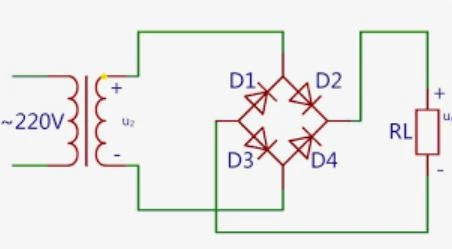Bridge Rectifier Explained: Principles, Performance, And Selection Guide
1. What Is a Bridge Rectifier?

A bridge rectifier is a circuit that converts alternating current (AC) into pulsating direct current (DC) using four diodes arranged in a bridge configuration. Compared with half-wave or center-tap full-wave rectifiers, a bridge rectifier delivers current to the load during both positive and negative halves of the AC cycle, making it an efficient and cost-effective solution.
2. How It Works
The four diodes—D1, D2, D3, and D4—are connected so that:

(1)Positive Half-Cycle
When terminal A is positive and B is negative, D1 and D2 conduct. Current flows: A → D1 → load → D2 → B.
(2)Negative Half-Cycle
When A is negative and B is positive, D3 and D4 conduct. Current flows: B → D3 → load → D4 → A.
In both cases, the load sees current in the same direction, producing a unidirectional, pulsating DC output.
3. Key Characteristics
(1)Full-Wave Rectification
Both halves of the AC waveform are used, doubling the ripple frequency compared to the input.
(2)No Center-Tap Transformer Required
Unlike center-tap full-wave designs, only a two-wire secondary winding is needed.
(3)Higher DC Voltage
For the same transformer voltage (Vrms), a bridge rectifier yields approximately 0.9 × Vrms, versus 0.45 × Vrms for a center-tap.
(4)Diode Voltage Drops
Each conduction path includes two diode drops (about 2 × 0.7 V for silicon diodes), which slightly reduces efficiency.
4. Common Applications
(1)Switch-Mode Power Supplies (SMPS)
Provides the DC bus for high-frequency converters.
(2)Linear Power Supplies
Feeds the smoothing capacitors before regulation by linear regulators.
(3)DC Motor Drives
Used in regenerative braking circuits to recover energy back into the system.
(4)Battery Chargers
Converts AC mains to DC for charging batteries in portable devices.
5. How to Choose the Right Bridge Rectifier
(1)Average Forward Current (IF(AV))
Select a rectifier whose rated average current exceeds your load current by at least 20–50%.
(2)Peak Repetitive Reverse Voltage (VRRM)
Choose a device with a VRRM at least 1.5× higher than the maximum peak voltage of your AC source.
(3)Forward Voltage Drop (Vf)
Lower Vf (e.g., using Schottky diodes) reduces conduction losses and improves efficiency.
(4)Thermal Considerations
Check thermal resistance (θJA, θJC) and ensure adequate heatsinking or PCB copper area for your power dissipation.
(5)Package Style
Small-Signal Bridge: SMD or small through-hole for currents up to a few amps.
Power Bridge Module: Bolt-down or large flat packages for high-current applications.
6. Layout and Design Tips
(1)Input Filtering
Place an X-class capacitor or RC snubber across the AC inputs to suppress surge currents and EMI.
(2)Output Filtering
Use a bulk electrolytic capacitor followed by a low-ESR bypass capacitor to smooth the pulsating DC.
(3)Trace Routing
Keep high-current paths short and wide. Mount the rectifier close to the transformer secondary to minimize loop inductance.
(4)Heatsinking
Ensure good thermal contact between the bridge package and any heatsink or PCB copper pour.
(5)EMI Mitigation
Add common-mode chokes or Y-capacitors as needed to meet EMC requirements.
7. Conclusion
Bridge rectifiers combine simplicity, efficiency, and low cost, making them the go-to choice for converting AC to DC in a wide range of power supplies. By selecting the right current and voltage ratings, managing heat effectively, and following good PCB layout practices, you can achieve reliable and efficient DC power for your designs.